Throughout medieval times, plague was a word that struck fear into the hearts of all that heard it whispered or shouted in their towns and cities. In this activity the pupils will find out what ‘plague’ actually is and how it was spread as well as the shocking news that plague is still with us today.
Suitable For: Years 3 to Year 6
Learning Focus:
- To understand that plague can refer to several diseases and describes the effect of a disease, not the disease itself
- Recognise that although many diseases are still with us today, medical science has helped us minimise their effect, cure or even prevent them!
- Understand the reasons why certain parts of the world are still prone to plague
Activity One – What is Plague?
Ask the pupils if they know what plague or as it is commonly referred to, ‘The Plague’, is?
You are likely to receive the answer that it was a major disease that killed hundreds of thousands of people in medieval and later. That’s only part of the truth for it was a generic name given to major epidemics of disease that swept Europe at those times.
One such plague was the Black Death which reduced the world’s population by a third between 1347 and 1351.
To find out more about the disease and how it spread use this downloadable card game for the pupils to play.
The cards are split into evidence (fact or fiction) and diagnostic cards which if the pupil gives the correct diagnosis, it gives them an extra turn.
The pupils should take it in turn to take a card and decide whether they are fact or fiction, plague or no plague. To check, they can turn over the cards.
Activity Two – Is Plague Still Around Today?
The simple answer is that yes, outbreaks happen regularly but it’s more easily controlled.
Use an outline map of the world and ask the pupils to find out when and where the most recent outbreaks of plague were – wikipedia gives a comprehensive and interesting list. Mark the information on the map. Ask them to identify the region where the disease is still prevalent.
Can they think of the reason why plague may still be found in those regions. For a hint, ask them to consider climate, poverty and access to preventative and curative medication.



